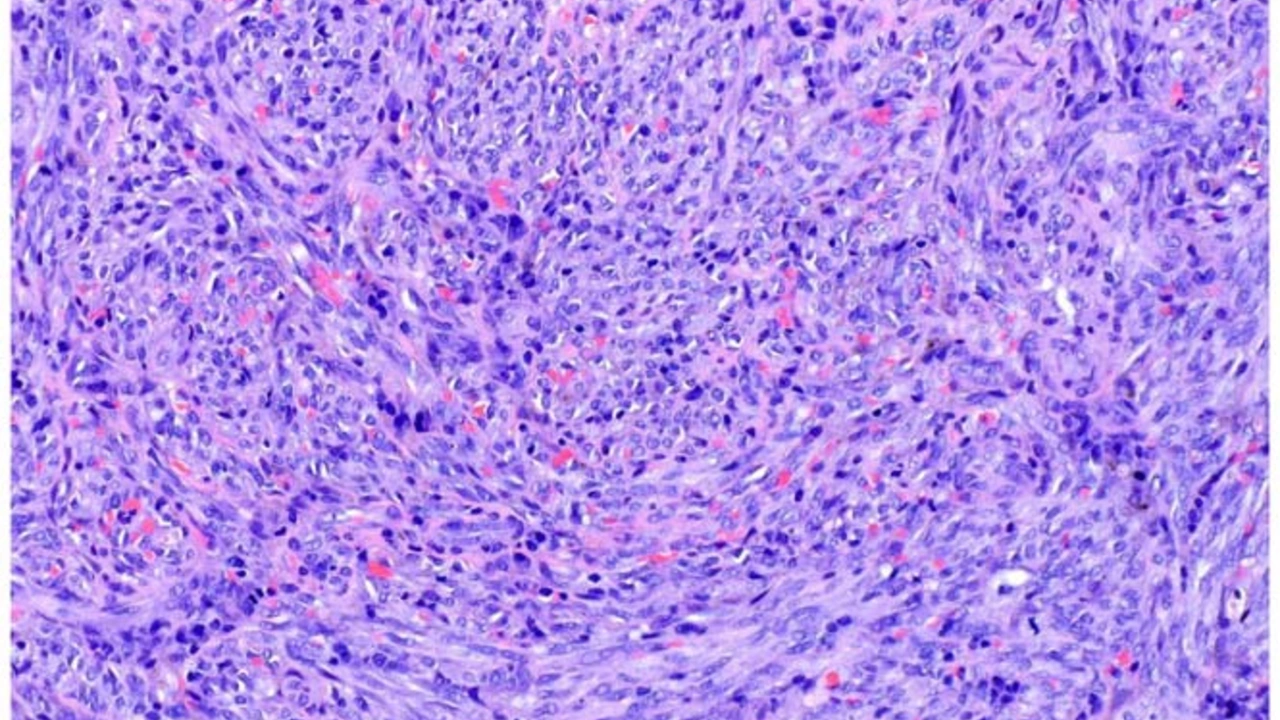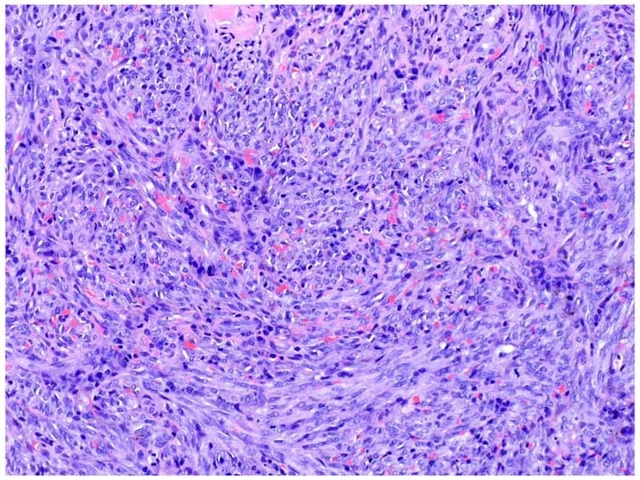Understanding Kaposi Sarcoma
Kaposi sarcoma is a rare type of cancer that affects the skin, mouth, and lymph nodes. It is caused by the human herpesvirus 8 (HHV-8), also known as Kaposi sarcoma-associated herpesvirus (KSHV). This cancer is more common in people with weakened immune systems, such as those with HIV/AIDS or organ transplant recipients. In this article, we will explore various treatment options for Kaposi sarcoma and provide an in-depth look at each option.
Diagnosis and Staging of Kaposi Sarcoma
Before diving into the treatment options, it is essential to understand the process of diagnosing and staging Kaposi sarcoma. The diagnosis is typically made through a biopsy of the affected tissue, and additional tests such as blood tests, X-rays, and endoscopy may be performed to determine the extent of the disease. The staging of Kaposi sarcoma is based on the extent of the tumor, the involvement of lymph nodes, and the presence or absence of metastasis (spread to other parts of the body). This information is crucial in determining the most appropriate treatment plan for each individual.
Localized Treatment Options
Localized treatment options are used for patients with a limited number of Kaposi sarcoma lesions that are confined to a specific area. These treatments target the cancerous cells directly and can include:
Cryotherapy
Cryotherapy is a procedure that uses extreme cold to freeze and destroy cancerous cells. A healthcare professional will apply a freezing agent, such as liquid nitrogen, to the affected area, causing the cells to die. This treatment is generally well-tolerated and can be repeated if necessary.
Electrodesiccation and Curettage
Electrodesiccation and curettage is a surgical procedure that involves removing the tumor by scraping it away with a curette (a sharp, spoon-shaped instrument) and then using an electric needle to destroy any remaining cancer cells. This procedure may be performed under local anesthesia and is generally used for smaller, more superficial lesions.
Radiation Therapy
Radiation therapy uses high-energy X-rays to kill cancer cells and shrink tumors. This treatment can be effective in treating localized Kaposi sarcoma lesions, particularly when other treatments are not appropriate or have not been effective. Radiation therapy is typically administered in multiple sessions over a period of several weeks.
Systemic Treatment Options
Systemic treatment options are used for patients with more advanced Kaposi sarcoma, including those with widespread skin lesions, lymph node involvement, or metastasis to internal organs. These treatments are designed to target cancer cells throughout the body and can include:
Chemotherapy
Chemotherapy is a drug treatment that works by stopping or slowing the growth of cancer cells. It can be given orally or intravenously (IV), and the specific drugs and treatment schedule will vary depending on the individual's needs and overall health. Some common chemotherapy drugs used to treat Kaposi sarcoma include liposomal doxorubicin, paclitaxel, and etoposide.
Immunotherapy
Immunotherapy is a type of treatment that helps the body's immune system fight cancer. Interferon-alpha is a type of immunotherapy drug that has been used to treat Kaposi sarcoma, particularly in patients with HIV/AIDS. This treatment can help to slow down the growth of cancer cells and may be used in combination with other therapies.
Targeted Therapy
Targeted therapy is a type of treatment that uses drugs to target specific molecules within cancer cells that are involved in the growth and spread of the disease. Targeted therapies for Kaposi sarcoma are still being studied in clinical trials, but they may offer a more personalized approach to treatment in the future.
Treating Kaposi Sarcoma in HIV/AIDS Patients
As previously mentioned, Kaposi sarcoma is more common in individuals with weakened immune systems, particularly those with HIV/AIDS. In these cases, treatment for Kaposi sarcoma may also include antiretroviral therapy (ART) to help control the HIV infection and strengthen the immune system. This can lead to a decrease in the size and number of Kaposi sarcoma lesions and may even result in complete remission of the cancer in some cases.
Managing Side Effects of Treatment
Many of the treatments for Kaposi sarcoma can cause side effects, some of which can be quite severe. It is essential to work closely with your healthcare team to manage any side effects that you may experience. This may include medications to control pain, nausea, or other symptoms, as well as supportive care measures such as physical therapy or nutritional counseling. It is crucial to report any new or worsening side effects to your healthcare team promptly so that they can help you manage them effectively.
Follow-up Care and Monitoring
After completing treatment for Kaposi sarcoma, it is important to have regular follow-up appointments with your healthcare team to monitor your recovery and check for any signs of the cancer returning. These appointments may include physical examinations, blood tests, and imaging studies, as well as discussions about any ongoing symptoms or concerns. Staying engaged with your healthcare team and following their recommendations for follow-up care can help to ensure the best possible outcome after treatment.
Conclusion
In conclusion, the treatment options for Kaposi sarcoma are varied and depend on the individual's specific circumstances, including the extent of the disease and the overall health of the patient. By working closely with your healthcare team and exploring the available treatment options, you can develop a comprehensive plan to manage your Kaposi sarcoma effectively and maintain the best possible quality of life.



Comments
I’m really sorry to hear how overwhelming this can feel, especially when dealing with a diagnosis that is tied to the immune system, and I appreciate how thorough this overview is; it certainly helps to demystify the options. The breakdown of localized versus systemic therapies gives a clear roadmap, and the emphasis on ART for HIV‑positive patients is reassuring. It’s good to know that side‑effect management is part of the conversation, because nobody wants unexpected complications, and the follow‑up recommendations feel realistic.
Cryotherapy sounds pretty straightforward.
Oh, dear reader, let us plunge into the magnificent tapestry of oncologic artistry that Kaposi’s Sarcoma treatments truly embody! 🌟 First, we behold the chilling elegance of cryotherapy, a frozen ballet that shatters malignant cells with the poise of a winter’s waltz. Then, the electrifying drama of electrodesiccation and curettage emerges, a duel of sparks and steel that whispers promises of eradication. Radiation therapy follows, ushering in a radiant cascade of photons, each a disciplined soldier marching towards tumor diminution. Meanwhile, on the systemic front, liposomal doxorubicin pirouettes delicately within the bloodstream, delivering its chemotherapeutic kiss with uncanny precision. Paclitaxel, that tenacious taxane, storms the cellular arena, arresting division like a tyrant silencing dissent. Interferon‑alpha, the immunological maestro, conducts the host’s defenses, coaxing them to recognize and reject the insidious virus‑driven foe. And let us not forget the burgeoning frontier of targeted therapy, those molecular keys seeking to unlock the very locks that bind the cancer’s growth. For those battling HIV, antiretroviral therapy stands sentinel, restoring vigor to the immune army, turning the tide in this relentless war. Side‑effects, those pesky gremlins, are tamed with compassionate care, analgesics, anti‑nausea potions, and nutritional alchemy. Follow‑up appointments become the rhythm of vigilance, a metronome ensuring no sinister resurgence. In this grand symphony, each modality plays a vital note, harmonizing to compose a future where Kaposi’s Sarcoma is but a fleeting movement in the opus of life. 🎭😊
The concise summary of treatment stages helps a lot. It’s clear and to the point.
Reading this really lifts my spirits, especially the part about how ART can shrink lesions dramatically. It feels like there’s a genuine partnership between patients and doctors, which is super encouraging. The variety of options means there’s hope no matter how advanced the disease is, and that’s incredibly empowering. Keep the optimism flowing, because every bit of positive energy helps the healing journey!
Honestly, the article feels a bit watered‑down for a specialist audience; the clinical trial references are missing, and the tone borders on a generic health blog. Still, the layout is clean enough for laypeople, albeit overly simplistic.
Just a note on terminology: the piece mentions “liposomal doxorubicin” and “paclitaxel” without clarifying dosing schedules, which can be crucial for patient adherence. Also, the distinction between interferon‑α and newer checkpoint inhibitors could have been highlighted as a potential future direction. Overall solid information, but a few grammar tweaks would improve readability.
One could argue that the drama of cancer treatment is over‑hyped, yet the clinical facts stand firm.
It’s fascinating how treatment protocols differ across continents; in some regions cryotherapy is the first line, while in others systemic chemotherapy is preferred. Understanding these cultural nuances can help patients navigate international care options.
Great optimism, Jennifer! It’s truly uplifting to see such a hopeful outlook. Though, let’s not forget that access to these therapies can be uneven, especially in low‑resource settings. Still, the emphasis on patient‑doctor collaboration is spot on.
Look, the rosy picture you paint ignores the harsh reality of drug shortages and bureaucratic red tape. Patients often get stuck waiting for weeks, if not months, for chemo slots. So while your cheerleading is cute, it’s grossly out of touch with the ground‑level struggle.
Global treatment variance is a real thing.
Hey there! Just wanted to add that for patients who might struggle with the jargon, breaking down each therapy into everyday analogies (like "freezing out the bad guys" for cryotherapy) can make the info way more digestible. Also, double‑check any typos before publishing-nothing kills credibility faster than a stray "treament".